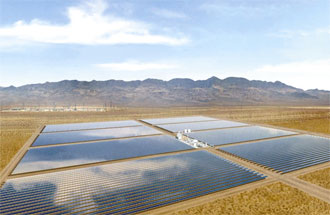New Policies Promote “THE BETTER WAY”
By Jim Harvey (Alliance for Responsible Energy Policy, From JOHNSON VALLEY JOURNAL • March-April 2009)
Legislators are elected to look out for the best interests of the people that sent them into office in the first place. It is the policies they enact that help shape the direction we will take as we forge our way through the 21st Century.
One of the most controversial challenges we face today is how to increase production and distribution of renewable energy supplies, and begin to leave behind us the antique technologies of long distance transmission and smoke/steam spewing remote generation.
Recently several changes in State and National energy policy were enacted that are well worth noting. Fortunately they do not fit the long standing tradition of energy legislation that has
almost always benefited Big Energy and their stranglehold over consumers.
Slowly but surely our law-makers are beginning to realize that the participation of home and business owners in renewable energy generation is the cleanest and fastest 21st Century solution for increasing the use of renewables. It is also essential in moving us towards clean energy independence.
TAX CREDITS
In November 2008, Congress finally lifted the $2000 cap on the 30% tax credit for home
and business owners who invest in energy efficiency improvements like rooftop solar PV panels. This now means we get the full 30% credit on the entire cost of our investment. If we invest $20,000 for example, we are now eligible for the full $6,000 tax credit.
This is in addition to the California Solar Initiative rebates still available. Many more consumers will most certainly install rooftop solar systems as a result of this long needed policy revision. Congress finally got one right.
(Incidentally, Big Energy projects like wind farms and transmission lines have always been conveniently exempt from this cap. And because utilities will never accept a fair and level playing field, in response they are now asking congress to convert their tax credit directly into an immediate cash rebate. They never quit!)
LOW INTEREST LOANS
At the state level, in July 2008, California enacted AB 811 legislation. This energy policy enables municipal and county authorities to fund loans for homes and businesses to improve energy efficiency and install rooftop solar systems.
These low risk loans are first liens on the property, encouraging low interest rates. As such, they are also repayable through the property tax collection system. Because the loan is tied to the home instead of the owner, it stays with the property when ownership changes.
The City of Palm Desert pushed heavily for this legislation, and since it was enacted, has already distributed over $2.5 million in loans to its residents and business owners. They sold out their first allotment so quickly, they have already allocated an additional $7.5 million. The City of Berkeley distributed their $1 million allocation in just minutes.
The Alliance for Responsible Energy Policy has been working with the City of Twentynine Palms in the hope that they will be the first city in our immediate area to provide AB 811 loans to their residents. This is looking very promising, and it would be nice to see Yucca Valley follow suit. San Diego is currently pursuing funds for AB 811 loans, as are Kern, Sonoma, and Ventura Counties.
Johnson Valley, Too?
For those of us in unincorporated rural areas like Johnson Valley, the County of San Bernardino would be our source for these loans. AREP plans to begin a petition drive and meet with County officials immediately, hoping to encourage County participation.
People like Carl Zichella of Sierra Club, and others in organizations like NRDC [National Resource Defense Council], Wilderness Society, and Environment America, have been justifying their outrageous support for massive industrial scale solar, wind, and transmission projects by citing low residential and business renewable energy generating participation. Palm Desert and Berkeley are clearly proving it is not a lack of will, keeping people from improving their energy use efficiency, rather it is a lack of good policy that stymies movement in this direction. When proper policies are enacted, people step up in large numbers and participate.
If Mr. Zichella and his “environmentalist” friends would instead focus their efforts on much needed policies like feed-in-tariffs and removing caps on PV system sizes allowed, we would not be in this drawn out debate on how best to increase renewable energy supplies in a safe and clean manner. Like Germany and 40 other nations, we would already be doing it.
For more information on how you can help AREP in our efforts to push for effective energy policies that favor public participation over continuing Big Energy monopolies, please visit
www.protectourlands.com

Renewable Energy Dividends
Alliance for Responsible Energy Policy explains how local energy generation can get a boost from Congress if we expand what Gainseville, Florida is doing:
Here is a video link sent by the people with Florida Alliance for Renewable Energy (FARE).
I hope you will watch this. It explains all the dynamics involved in FIT (Feed-In-Tariffs) or RED (Renewable Energy Dividends) -- effective and responsible renewable energy policy. This model is different from net metering, where you turn your meter backwards and receive a per kwh rate if you generate more than you use. It is based on the most successful German FIT policy, that offers a per kwh rate for every electron generated. There is a separate meter for this. Because the FIT or what the Floridians are calling "Renewable Energy Dividends" is higher than the per kwh rate the consumer pays, they receive more for their generation than in a net metering system. There is a difference.
For example: In net metering like here in CA, if you pay 15 cents kwh for electricity to the utility, and you install a net metering photovoltaic (PV) system that zeros out your bill, you would in essence receive 15 cents per kwh for your renewable energy generation. You are trading your electrons 1 for 1. If you generate more than you use, you give that power to the utilities as a gift.
In Germany, Spain, etc, and under the FARE proposal for Florida, feed-in-tariffs or renewable energy dividends work differently and are much more effective at increasing renewable energy supplies. Under this model, home and business participants install a PV system that is metered separately from their regular consumption meter. They still pay their regular per kwh electricity bill as normal (say 15 cents), but are separately compensated at a higher rate for all of their renewable energy output (hence the term "tariff"). In Florida's case, the proposed rate is 25 cents. Rate payers send a check and also receive a check. Under this policy, renewable energy generation participants have the potential to actually earn a surplus at the end of the month by receiving a check that is larger than the one they send. This introduces real financial incentives to oversize their systems which accelerates and increases their return on investment, and consequently ramps up huge amounts of clean renewables that do not require scraping any land, consuming large amounts of water, transmission, eminent domain, diminished property values, etc. Manufacturing and installation jobs are instantly created. Banks are happily loaning money for these very secured loans, and local economies are boosted by increased disposable income. Furthermore, environmentalists should be elated that truly clean renewable energy supplies are available immediately - there is no 3 + year wait for utility scale project approval and construction on public lands -- "disturbed" or "undisturbed". We want renewable energy now, right?
Currently we do not have a serious FIT or RED policy in California. We have net metering, which although is better than nothing, by comparison it is easy to see that FIT policy will provide the real incentives for consumer renewable generation participation that net metering does not and has not. The low projections for point of use PV contributions to Renewable Portfolio Standards are based on current lackluster numbers caused by poor policy that does not include proven effective FITs. Those that use these low figures to make their case for industrial scale renewables, and then do nothing to advance the case for FIT policies, are simply self-fulfilling their own prophecy. They are causing what they are complaining about. This must stop.
Our own government's NREL (National Renewable Energy Laboratories) under the U.S. Department of Energy has concluded that FIT policy is the fastest and least expensive way to ramp up renewable energy supplies here in the U.S. The U.S. Department of Energy itself reports that urban load centers are more than capable of meeting their renewable energy needs through point of use PV solar energy generated within. This is what congress needs to hear and be reminded of. Congress must follow the recommendations of our government's own agencies like the DOE and NREL, whose expertise is energy generation and distribution. Carl Zichella is far from qualified to dispute their findings. In fact he is least qualified. Read his offered testimony to the hearings.
Question: If we cannot put solar in the desert, where can we put it? Answer: Just like Germany and 45 other nations -- on home, school, shopping mall, and factory rooftops, and over parking lots: already developed surfaces.
CSP is very site dependent - The "red" and "orange" zones on the U.S. solar resources map -- desert Southwest. Point of use PV is not. Germany does not have the "red" and "orange" zones like the southwest, yet they are currently adding almost 2000 MW of building integrated/rooftop PV annually -- 10,000 MW total by 2011. We have no excuse here in the U.S. Our lawmakers need to understand this.
These are the winning arguments against remotely generated energy. Our lawmakers either want clean, fast, and least expensive renewable energy supplies and are willing to support THE proven ways to achieve this, or instead they will promote far more expensive, wilderness killing, transmission dependent, water wasting, 3 + year wait for approval, non greenhouse gas reducing, steam spewing, property value reducing, eminent domain inflicting, industrial scale remote generation -- and show they are not interested in fast, clean, renewables. The choice is clear.
--Jim Harvey, May 2009 (Alliance for Responsible Energy Policy)
HOME..........Solar in the Desert..........The Problem..........The Solution
Palm Desert Congressional Hearing on Renewable Siting on Public Lands - May 11, 2009
